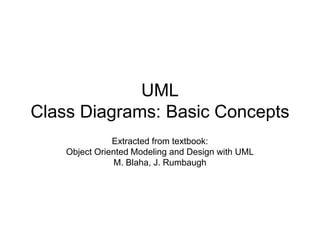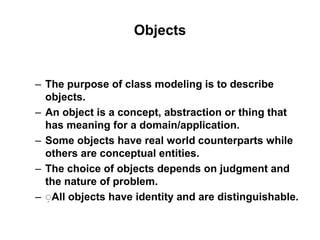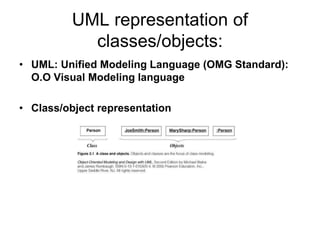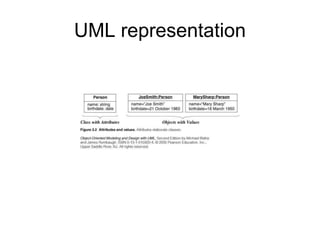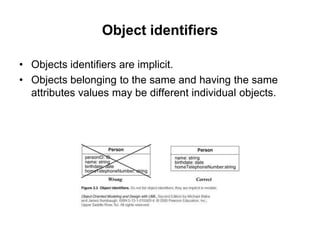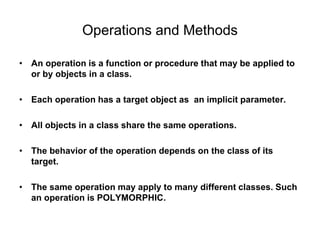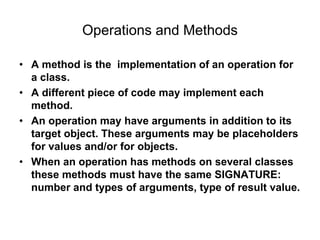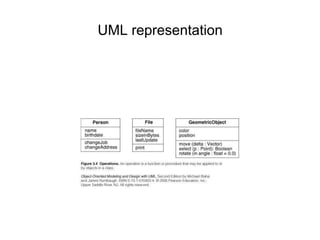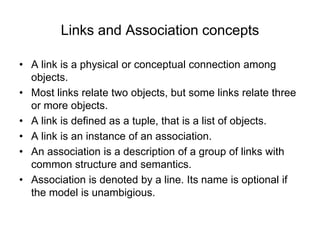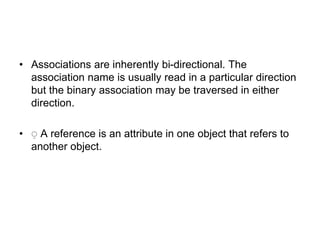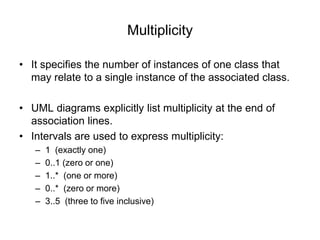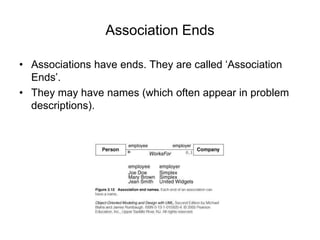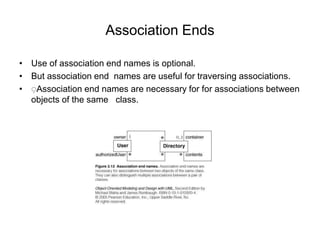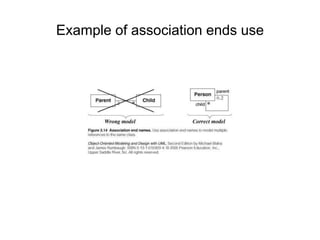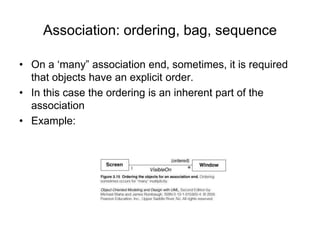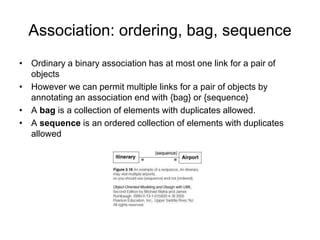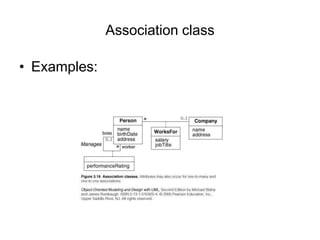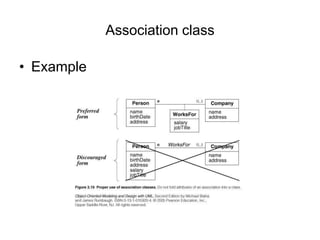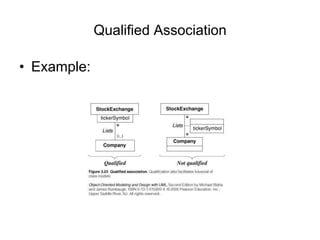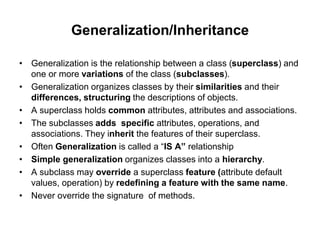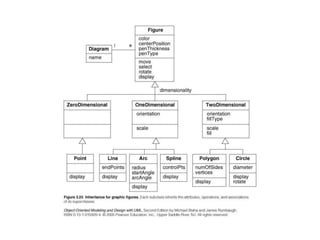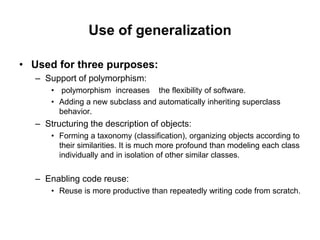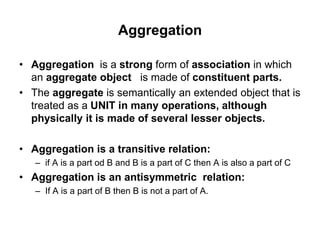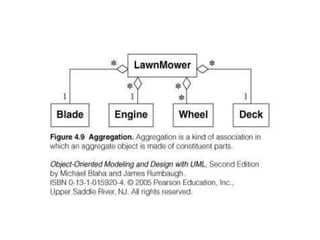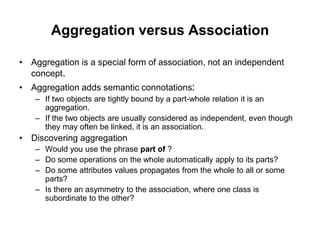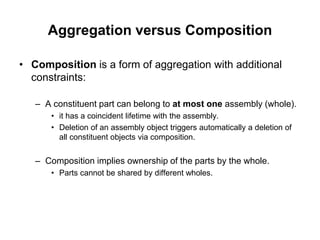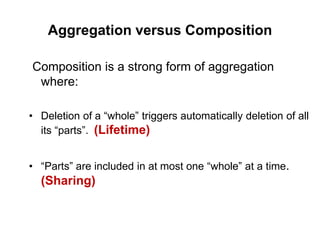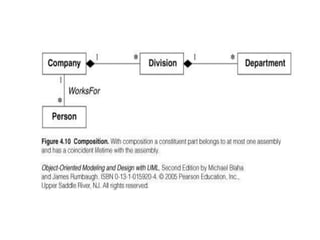cse 355 UML class diagram software engineering.ppt
- 1. UML Class Diagrams: Basic Concepts Extracted from textbook: Object Oriented Modeling and Design with UML M. Blaha, J. Rumbaugh
- 2. Objects ÔÇô The purpose of class modeling is to describe objects. ÔÇô An object is a concept, abstraction or thing that has meaning for a domain/application. ÔÇô Some objects have real world counterparts while others are conceptual entities. ÔÇô The choice of objects depends on judgment and the nature of problem. ÔÇô ┘ÉAll objects have identity and are distinguishable.
- 3. Classes ÔÇô An object is an instance ÔÇô occurrence ÔÇô of a class ÔÇô ┘É A class describes a group of objects with the same properties (attributes), behavior (operations), kinds of relationships, and semantics. ÔÇô The objects in a class share a common semantic purpose, above and beyond the requirement of common attributes and behavior. ÔÇô By grouping objects onto classes we abstract a problem.
- 4. UML representation of classes/objects: ÔÇó UML: Unified Modeling Language (OMG Standard): O.O Visual Modeling language ÔÇó Class/object representation
- 5. Values and attributes ÔÇó Value : piece of data. ÔÇó Attribute: a named property of a class that describes a value held by each object of the class. ÔÇô Attributes may be discovered by looking for adjectives or by abstracting typical values. ÔÇô DonÔÇÖt confuse values with objects: ÔÇó An attribute should describe values, not objects. ÔÇó Unlike objects, values lac identity
- 7. Object identifiers ÔÇó Objects identifiers are implicit. ÔÇó Objects belonging to the same and having the same attributes values may be different individual objects.
- 8. Operations and Methods ÔÇó An operation is a function or procedure that may be applied to or by objects in a class. ÔÇó Each operation has a target object as an implicit parameter. ÔÇó All objects in a class share the same operations. ÔÇó The behavior of the operation depends on the class of its target. ÔÇó The same operation may apply to many different classes. Such an operation is POLYMORPHIC.
- 9. Operations and Methods ÔÇó A method is the implementation of an operation for a class. ÔÇó A different piece of code may implement each method. ÔÇó An operation may have arguments in addition to its target object. These arguments may be placeholders for values and/or for objects. ÔÇó When an operation has methods on several classes these methods must have the same SIGNATURE: number and types of arguments, type of result value.
- 11. Links and Association concepts ÔÇó A link is a physical or conceptual connection among objects. ÔÇó Most links relate two objects, but some links relate three or more objects. ÔÇó A link is defined as a tuple, that is a list of objects. ÔÇó A link is an instance of an association. ÔÇó An association is a description of a group of links with common structure and semantics. ÔÇó Association is denoted by a line. Its name is optional if the model is unambigious.
- 12. Examples
- 13. ÔÇó Associations are inherently bi-directional. The association name is usually read in a particular direction but the binary association may be traversed in either direction. ÔÇó ┘É A reference is an attribute in one object that refers to another object.
- 14. Multiplicity ÔÇó It specifies the number of instances of one class that may relate to a single instance of the associated class. ÔÇó UML diagrams explicitly list multiplicity at the end of association lines. ÔÇó Intervals are used to express multiplicity: ÔÇô 1 (exactly one) ÔÇô 0..1 (zero or one) ÔÇô 1..* (one or more) ÔÇô 0..* (zero or more) ÔÇô 3..5 (three to five inclusive)
- 15. Association Ends ÔÇó Associations have ends. They are called ÔÇÿAssociation EndsÔÇÖ. ÔÇó They may have names (which often appear in problem descriptions).
- 16. Association Ends ÔÇó Use of association end names is optional. ÔÇó But association end names are useful for traversing associations. ÔÇó ┘ÉAssociation end names are necessary for for associations between objects of the same class.
- 17. Example of association ends use
- 18. Association: ordering, bag, sequence ÔÇó On a ÔÇÿmanyÔÇØ association end, sometimes, it is required that objects have an explicit order. ÔÇó In this case the ordering is an inherent part of the association ÔÇó Example:
- 19. Association: ordering, bag, sequence ÔÇó Ordinary a binary association has at most one link for a pair of objects ÔÇó However we can permit multiple links for a pair of objects by annotating an association end with {bag} or {sequence} ÔÇó A bag is a collection of elements with duplicates allowed. ÔÇó A sequence is an ordered collection of elements with duplicates allowed
- 20. Association class ÔÇó UML offers the ability to describe links of association with attributes like any class. ÔÇó An association class is an association that is also a class.
- 23. Qualified Association ÔÇó A qualified association is an association in which an attribute called Qualifier disambiguates the objects for a ÔÇÿmanyÔÇÖ associationÔÇÖ end. ÔÇó A qualifier selects among the target objects, reducing the effective multiplicity fro ÔÇÿmanyÔÇÖ to ÔÇÿoneÔÇÖ. ÔÇó Both below models are acceptable but the qualified model adds information.
- 25. Generalization/Inheritance ÔÇó Generalization is the relationship between a class (superclass) and one or more variations of the class (subclasses). ÔÇó Generalization organizes classes by their similarities and their differences, structuring the descriptions of objects. ÔÇó A superclass holds common attributes, attributes and associations. ÔÇó The subclasses adds specific attributes, operations, and associations. They inherit the features of their superclass. ÔÇó Often Generalization is called a ÔÇ£IS AÔÇØ relationship ÔÇó Simple generalization organizes classes into a hierarchy. ÔÇó A subclass may override a superclass feature (attribute default values, operation) by redefining a feature with the same name. ÔÇó Never override the signature of methods.
- 27. Use of generalization ÔÇó Used for three purposes: ÔÇô Support of polymorphism: ÔÇó polymorphism increases the flexibility of software. ÔÇó Adding a new subclass and automatically inheriting superclass behavior. ÔÇô Structuring the description of objects: ÔÇó Forming a taxonomy (classification), organizing objects according to their similarities. It is much more profound than modeling each class individually and in isolation of other similar classes. ÔÇô Enabling code reuse: ÔÇó Reuse is more productive than repeatedly writing code from scratch.
- 28. Aggregation ÔÇó Aggregation is a strong form of association in which an aggregate object is made of constituent parts. ÔÇó The aggregate is semantically an extended object that is treated as a UNIT in many operations, although physically it is made of several lesser objects. ÔÇó Aggregation is a transitive relation: ÔÇô if A is a part od B and B is a part of C then A is also a part of C ÔÇó Aggregation is an antisymmetric relation: ÔÇô If A is a part of B then B is not a part of A.
- 30. Aggregation versus Association ÔÇó Aggregation is a special form of association, not an independent concept. ÔÇó Aggregation adds semantic connotations: ÔÇô If two objects are tightly bound by a part-whole relation it is an aggregation. ÔÇô If the two objects are usually considered as independent, even though they may often be linked, it is an association. ÔÇó Discovering aggregation ÔÇô Would you use the phrase part of ? ÔÇô Do some operations on the whole automatically apply to its parts? ÔÇô Do some attributes values propagates from the whole to all or some parts? ÔÇô Is there an asymmetry to the association, where one class is subordinate to the other?
- 31. Aggregation versus Composition ÔÇó Composition is a form of aggregation with additional constraints: ÔÇô A constituent part can belong to at most one assembly (whole). ÔÇó it has a coincident lifetime with the assembly. ÔÇó Deletion of an assembly object triggers automatically a deletion of all constituent objects via composition. ÔÇô Composition implies ownership of the parts by the whole. ÔÇó Parts cannot be shared by different wholes.
- 32. Aggregation versus Composition Composition is a strong form of aggregation where: ÔÇó Deletion of a ÔÇ£wholeÔÇØ triggers automatically deletion of all its ÔÇ£partsÔÇØ. (Lifetime) ÔÇó ÔÇ£PartsÔÇØ are included in at most one ÔÇ£wholeÔÇØ at a time. (Sharing)
- 34. Propagation of operations ÔÇó Propagation is the automatic application of an operation to a network of objects when the operation is applied to some starting object. ÔÇó Propagation of operations to parts is often a good indicator of propagation.

